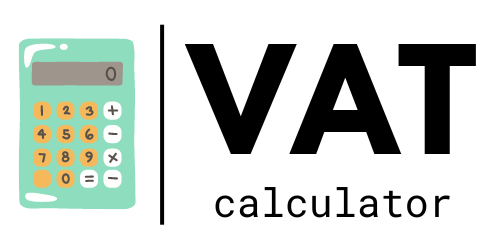VAT Calculator
Calculate VAT made easy: Enter your value and select include/exclude to get accurate results quickly.

Utilizing the VAT Calculator: Enter the total amount, select the VAT calculation method (inclusive or exclusive), specify the tax percentage,
and click the “Calculate” or “Enter” button to compute the VAT value.
The default setting for the online VAT calculator rate is configured for UK VAT calculations.
Why Do Accurate VAT Calculations Matter?
Understanding and calculating VAT correctly is necessary for businesses to comply with tax regulations and maintain financial transparency. Miscalculating VAT can lead to financial discrepancies, potential penalties, and non-compliance issues for a large enterprise or even a small startup. By using our user-friendly online VAT calculator, you can say goodbye to manual calculations and human errors, ensuring you stay ahead of your tax responsibilities.
How to use VAT Calculator Online
- To calculate the value-added tax for your purchase, simply type vatcalc.info in the URL bar and hit enter. This will take you to the website where you can perform the calculation.
- Enter your value and select your percentage.
- Select include or exclude depending on your preference.
Press the Enter button to see the results on the bar below the calculator.
How to Calculate VAT
Here’s how to calculate the VAT Amount!
You can use any of the following formulas to determine the VAT amount by using the information you have.
Including VAT from the Gross Amount:
VAT Amount = Gross Amount * (VAT Rate / (100 + VAT Rate))
Excluding VAT in the Gross Amount:
VAT Amount = Gross Amount / (1 + (VAT Rate / 100))
Features of the VAT Calculator
Our online VAT calculator doesn’t just perform as a tool, but it becomes your perfect companion when it comes to navigating the complexities of Value Added Tax. Our feature-packed VAT calculator is helping thousands of business owners,
accountants, and individuals manage their personal finances and streamline their tax calculations.
Here are the key features and functionalities of the VAT Calculator that you’ll love:
- Inclusion and Exclusion Options
One of the main features of our VAT calculator is its flexibility to handle VAT-inclusive and VAT-exclusive calculations. So, it makes it easier to find the total price with VAT included or determine the net amount by excluding VAT. Just by toggling between the two options, you can get accurate results within a matter of seconds. - User-Friendly Interface
Our user-friendly interface is designed keeping simplicity in mind to give the users a smooth experience. You don’t need any special knowledge or to be a tax expert as you can use it effectively and easily. Intuitive input fields and clear labels guide you through the process, ensuring a seamless experience for every user, regardless of their level of expertise. - Real-Time Result Display
When it comes to financial decisions, time is of the essence. Considering this, our VAT calculator displays real-time results. You just need to input the figures and adjust the settings; you’ll show the updates about the VAT amount and Net price instantly. It ultimately provides instant insights while reducing awkward waiting time. - Customizable VAT Rates
VAT rates vary as per the countries and regions and interestingly our calculator acknowledges this diversity well. Set the tax rates tailored to your specific requirement with its customizable VAT rate options. Individuals or businesses dealing the transactions across borders ensure precise calculation through this quality feature. - Comprehensive Breakdown
Understanding the breakdown of a calculation is crucial for transparency and verification. Our VAT calculator provides a comprehensive breakdown of the calculation process, showcasing the gross amount, VAT amount, and net amount separately. This level of detail empowers you to verify the accuracy of the results and track each element of the transaction.
Read Further information on VAT taxation is available on Wikipedia.
- Deducting VAT from the total amount:
The formula for excluding VAT from the gross amount is as follows: Divide the gross amount by 1 + the VAT percentage (e.g., for 15%, divide by 1.15), then subtract the gross amount. Multiply the result by -1 and round to the nearest value (including eurocents). The final two operations are optional since you can already see the VAT value before performing them. - Including VAT in the net amount:
Simple process. Just multiply the net amount by 1 + the VAT percentage (e.g., multiply by 1.15 for a 15% VAT), and you’ll obtain the gross amount. Alternatively, multiply by the VAT percentage to determine the VAT value. - Read Further information on VAT taxation is available on Wikipedia.
Frequently Asked Questions (FAQs) about VAT
VAT, or Value Added Tax, is a consumption tax added to the value of goods or services at each stage of production or distribution. It is ultimately borne by the end consumer.
VAT is calculated as a percentage of the sale price. The standard rate varies by country, and some items may be subject to reduced or zero rates. The calculation involves multiplying the net sale price by the applicable VAT rate.
VAT is typically paid by the end consumer. However, businesses are responsible for collecting and remitting the tax to the government. In the business-to-business (B2B) context, the VAT is often recoverable.
Input VAT is the tax paid on purchases of goods and services by a business. Output VAT is the tax collected from customers on sales. The difference between Output VAT and Input VAT is what a business remits to the tax authorities.
While many goods and services are subject to VAT, certain items may be exempt or eligible for reduced rates. Basic necessities, such as food and healthcare, may be subject to lower rates or exemptions.
VAT is a multistage tax applied at each stage of production or distribution, while sales tax is typically a single-stage tax applied only at the point of retail sale. VAT is more widely used globally, while sales tax systems vary by jurisdiction.
In many countries, businesses can reclaim the VAT they pay on purchases (Input VAT) against the VAT they collect on sales (Output VAT). This helps prevent double taxation.
The threshold for mandatory VAT registration varies by country. Businesses that exceed this threshold must register for VAT and collect the tax on their sales.
The frequency of VAT returns varies by jurisdiction. In some countries, businesses submit VAT returns monthly, quarterly, or annually, reporting their sales, purchases, and the resulting VAT liability.
VAT Calculator Online provides a user-friendly tool for calculating VAT. It helps businesses and individuals quickly determine the VAT amount based on the sale price and applicable tax rate.
The editors and site owner bear no responsibility for any harm or profit loss resulting from the utilization or inability to utilize information on this site. Users are using this website at their own risk.
Read about the Privacy Policy.
